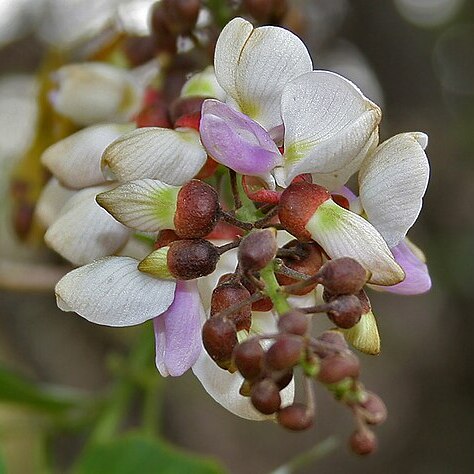Tree or shrub 1.5–25 m high, without buttresses; branchlets glabrous. Leaves pinnate, 13–33 cm long, mostly with 5–7 leaflets; leaflets elliptic, 4–20 cm long, cuneate to rounded at base, entire, usually acuminate, glabrous, glossy. Pseudoracemes 4–20 cm long, suberect; pedicels 0.7–1.5 cm long, finely pubescent. Calyx 4–5 mm long, finely pubescent. Standard broadly obovate, 1.1–1.8 cm long, with basal auricles, softly brown-hairy outside, pale pink, greenish at base inside; wings adhering to keel, deep pink. Fruit oblong-ellipsoidal, 2.5–3 cm long, oblique, with an apical beak, somewhat flattened, rather woody, eventually dehiscent. Seed usually solitary, reniform, 1.6–2 cm long, compressed; testa brittle.
More
A tree up to 15-25 m high and 45 cm across the trunk. It loses its leaves during the year. The bark is soft and greyish green. It is smooth or covered with rounded swellings. The leaves are alternate and compound with 3 or more leaflets. There is a leaflet at the end. They are smooth and pointed at the tip. They are 7 to 10 cm long. The leaves have a bitter smell when squashed. The flowers are purplish and about 1.5 cm long in racemes. The pods are oval and with one seed. The pod tapers on both sides to sharp points. The seeds are kidney shaped.
Semi-deciduous coastal monsoon vine forest and thicket, monsoon vine forest along rivers and inland regions, occasionally in mangroves (Wightman & Andrews 1989: 74). Coastal and riverine habitats, primarily in humid tropical and subtropical areas, 500–2500 mm rainfall per annum (Csurhes & Hankamer 2016). On Christmas Island common as a tree on all terraces on the east of the island, and as shrubs among limestone pinnacles and rocks (Du Puy & Telford 1993: 211).
More
A tropical plant. It can grow on a wide range of well-drained soils. They are found along the coastal regions from northern Luzon to southern Mindanao in the Philippines. In Samoa it grows from sea level to 100 m altitude. In India it grows along the banks of streams. In the Cairns Botanical Gardens. It is salt tolerant. It suits hardiness zones 9-11.
The hard wood is used for temporary housing constructions, the twigs and small branches used as a toothbrush, and the leaves used in local medicine (Adema 2000: 411). It is utilised as a shade tree in coastal areas, e.g. planted in parks and on verges around Darwin as a screen and shelter tree (Wightman & Andrews 1989: 74). A biofuel crop (oil-rich seeds), e.g. in India, fodder plant and used in land reclamation; see Csurhes & Hankamer (2016) and references therein. A useful timber tree, producing hard wood with a beautiful grain but not very durable and mainly used in cabinet making. The bark can be used to make ropes. The foliage is a good fodder and green manure. The black, foetid roots contain a fish poison. Extracts from the root have been used to treat sores and stomach ulcers. The seeds yield pongam oil, reputed to heal herpes, scabies and rheumatism. A common ornamental and street tree. It is a host plant for lac insects which cause the tree to secrete a resinous substance (lac) which is used as varnish. (Du Puy & Telford 1993: 211).
More
The seeds are edible cooked. CAUTION: It is probably poisonous with a toxin which causes vomiting. The seeds have a bitter oil.

